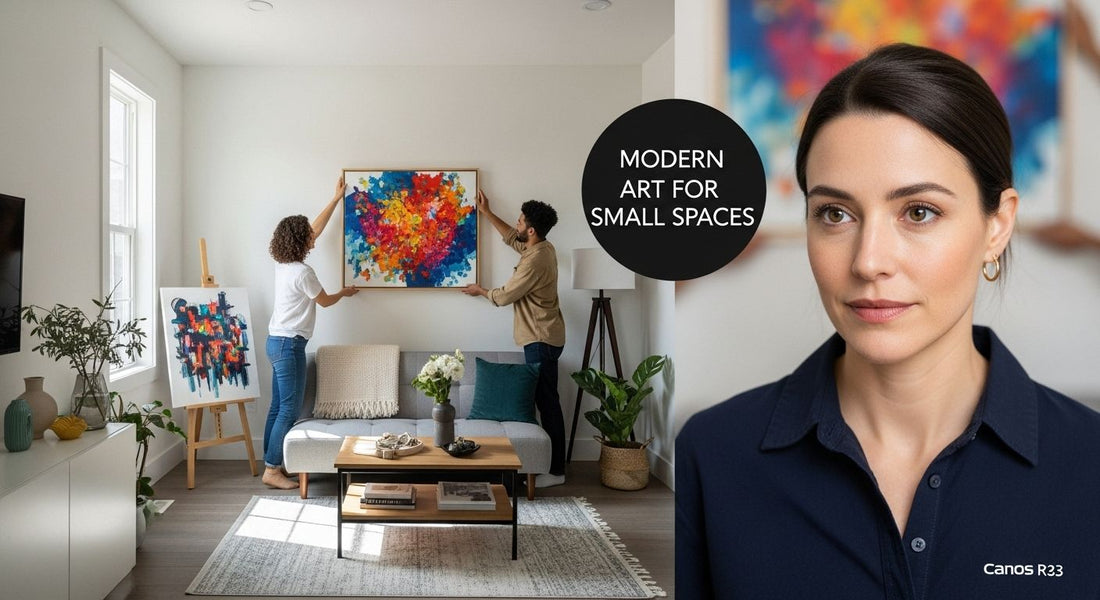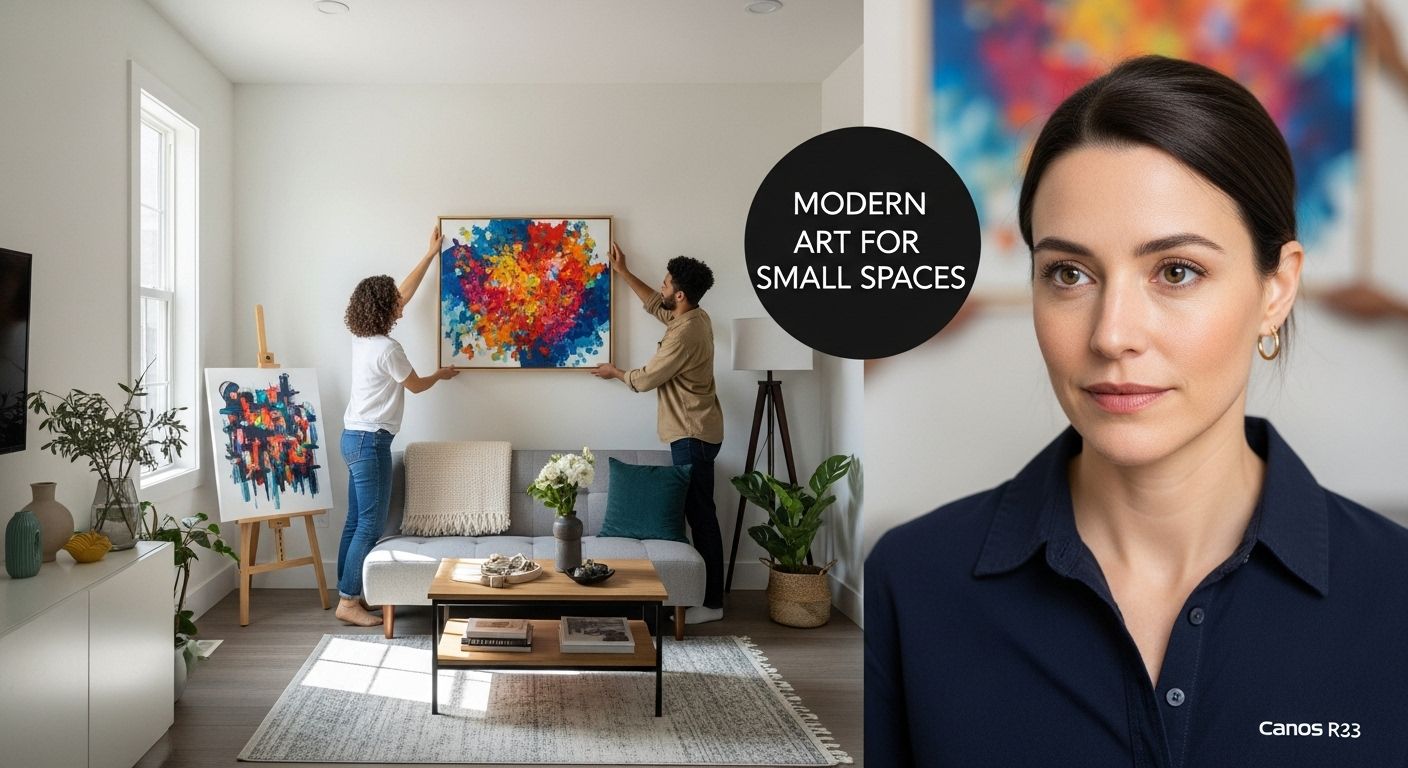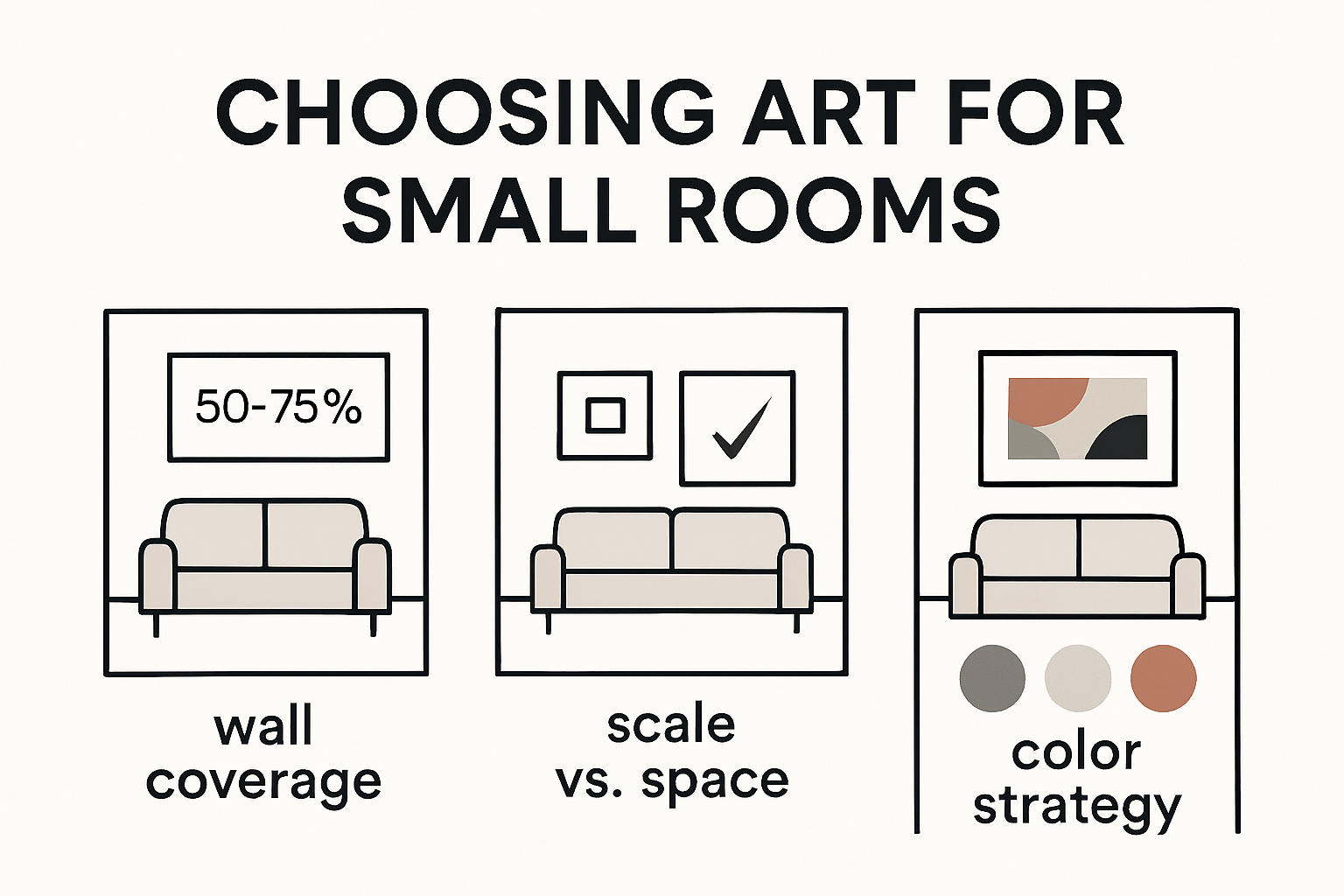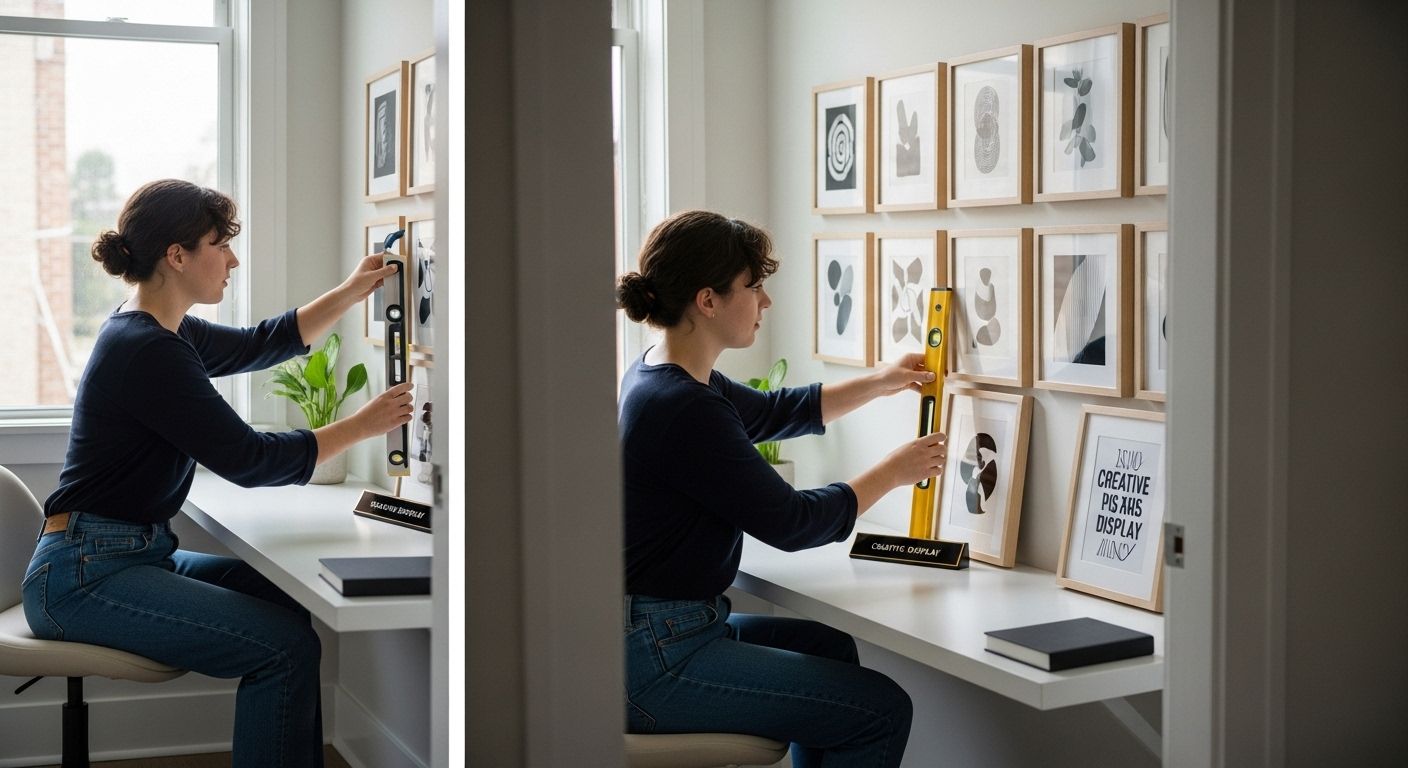
Modern Art for Small Spaces: Creative Display Ideas

Modern art can completely change the way a small room feels. Experts say artwork covering 50 to 75 percent of your wall space makes even the tiniest areas appear larger and more dynamic. Most people think limited square footage means you have to sacrifice creativity or settle for boring walls. In reality, the right art and smart display tricks can make compact spaces feel like curated mini galleries that grab your eye at every turn.
Table of Contents
- Choosing The Right Art For Small Spaces
- Creative Display Techniques For Limited Areas
- Supporting Independent Artists In Small Spaces
- Gift Ideas: Art For Special Occasions
Quick Summary
| Takeaway | Explanation |
|---|---|
| Choose art at proper scale | Select artwork that covers 50-75% of wall space to enhance visual impact without cluttering the area. |
| Use vertical compositions | Artwork with vertical designs creates an illusion of height, making small spaces feel larger and more open. |
| Strategically place artworks | Avoid multiple small pieces; opt for statement pieces or carefully arranged gallery walls to create visual harmony. |
| Explore unconventional display methods | Mount artwork in unexpected locations or use flexible hanging systems to maximize limited space without damaging walls. |
| Give meaningful art gifts | Personalize art gifts to reflect recipient’s interests and experiences, transforming them into cherished, intimate pieces of decor. |
Choosing the Right Art for Small Spaces
Selecting artwork for compact living spaces requires strategic thinking and a keen eye for visual balance. The right art can transform a small room from cramped to captivating, making intentional choices crucial for art enthusiasts working with limited square footage.
Scale and Proportion Matter Most
In small spaces, art selection is all about proportions. Oversized pieces can overwhelm a room, while pieces too small might look insignificant. Learn more about curating art for compact spaces to maximize visual impact without cluttering your environment.
Experts recommend choosing artwork that occupies approximately 50-75% of your available wall space. According to interior design research from Apartment Therapy, this proportion creates a balanced visual experience without making the room feel congested. Large abstract pieces with minimal detail can create an illusion of depth, making your space feel more expansive.

Color and Composition Strategies
Color plays a pivotal role in art selection for compact areas. Light, neutral tones can make a room feel more open, while strategic pops of color can add visual interest without overwhelming the space. Monochromatic art collections or pieces with subtle color gradients work exceptionally well in smaller rooms.
Consider artwork with vertical compositions to draw the eye upward, creating a sense of height. Tall, narrow canvas prints can make ceilings appear higher and rooms more spacious. Minimalist art styles like geometric abstracts or line drawings are particularly effective in small spaces, offering visual intrigue without visual chaos.
Strategic Placement Techniques
Placement is as critical as the artwork itself. Avoid clustering multiple small pieces, which can make walls feel cluttered. Instead, opt for a single statement piece or a carefully curated gallery wall with consistent framing and spacing. Mounting art slightly higher than traditional eye level can create an unexpected visual dynamic that makes rooms feel more dynamic.
Consider unconventional spaces for art display. Narrow hallways, above doorways, or even on floating shelves can become unexpected canvases. Reflective frames or pieces with metallic accents can also help bounce light around the room, creating a sense of openness.
Remember that art for small spaces is about creating visual harmony. Each piece should feel intentional, contributing to the room’s overall aesthetic without competing for attention. With thoughtful selection and strategic placement, even the most compact spaces can become stunning galleries of personal expression.
Creative Display Techniques for Limited Areas
Navigating the challenge of displaying art in compact spaces requires innovative thinking and strategic design approaches. Creative display techniques can transform limited areas into captivating visual experiences that maximize both aesthetic appeal and spatial efficiency.
Vertical and Layered Display Strategies
Vertical display techniques offer an exceptional solution for art presentation in small spaces. Learn about innovative display methods that expand your artistic possibilities beyond traditional wall hanging.
According to exhibition design research from the University of Washington, the ‘vista approach’ creates intentional sightlines that guide visual perception. This principle involves strategically positioning artwork to create depth and interest, even in constrained areas. Consider using tall, narrow shelving units that allow you to layer art pieces at different depths, creating a dynamic visual landscape that draws the eye upward and makes the space feel larger.
Implement floating shelves with varying heights to break monotony. Mix canvas prints, small sculptural elements, and framed pieces to create a three-dimensional gallery wall. This technique not only saves floor space but also adds architectural interest to your display.
Unconventional Mounting and Integration Techniques
Thinking beyond traditional wall hanging opens up numerous creative possibilities. Research on exhibition design emphasizes managing visual complexity by balancing artwork placement and cognitive load. This means being intentional about how and where you mount art.
Consider mounting artwork in unexpected locations: above doorways, on the backs of doors, or even on ceiling spaces. Magnetic wall systems and wire hanging solutions provide flexibility for renters or those wanting to frequently rotate their art collection. These systems allow for quick rearrangement without damaging walls, perfect for evolving small space designs.
Mirrors can serve as innovative art display companions. Placing artwork strategically near reflective surfaces can create the illusion of expanded space while doubling the visual impact of your chosen pieces. Lean larger canvas prints against walls instead of hanging them, which adds a casual, contemporary feel and reduces visual clutter.
Minimalist and Multi-Functional Display Solutions
The ‘visible storage’ method, originally developed by museum curators, offers inspiration for compact living spaces. This approach transforms storage into display, allowing artwork to serve both aesthetic and functional purposes. Install slim ledge shelves that can hold rotating art collections, books, and small decorative objects.
Consider multi-functional furniture pieces that integrate art display. Consoles with built-in gallery walls, coffee tables with display compartments, and room dividers with integrated artwork can transform practical furniture into artistic statements. These solutions are particularly effective in studio apartments or open-concept living spaces where every design element must serve multiple purposes.
Remember that creativity trumps square footage. By reimagining how art can be displayed, you can turn spatial limitations into opportunities for unique, personalized artistic expression. The key is to remain flexible, experimental, and true to your personal aesthetic vision.
To help you choose the most effective way to display your art in a small space, here’s a comparison of key art display techniques mentioned in this article and their unique benefits.
| Display Technique | Key Features | Benefits for Small Spaces |
|---|---|---|
| Vertical Arrangements | Tall, narrow compositions; shelving at varying heights | Enhances sense of height; makes room feel larger |
| Layered Display (Floating Shelves) | Mix of canvas, framed art, and objects at different depths | Adds dimension; maximizes wall and shelf space |
| Unconventional Mounting | Above doors, backs of doors, ceilings, magnetic/wire systems | Makes use of unexpected areas; flexible for frequent changes |
| Minimalist Visible Storage | Slim ledge shelves, visible storage, rotating collections | Multipurpose storage and display; keeps space uncluttered |
| Multi-Functional Furniture Integration | Gallery consoles, art-integrated tables/dividers | Combines decor and function; ideal for studio apartments |

Pro tip: Always maintain some negative space around your art displays. This prevents visual overwhelm and allows each piece to breathe, ensuring that even in small areas, your artwork remains the star of the show.
Supporting Independent Artists in Small Spaces
Supporting independent artists involves more than purchasing artwork. In small spaces, the challenge becomes creating meaningful connections and opportunities that amplify artistic voices while respecting spatial limitations.
Creating Collaborative Exhibition Opportunities
Explore unique ways to showcase emerging talent through innovative display strategies that benefit both artists and collectors. According to research from Grantmakers in the Arts, providing affordable and accessible spaces is crucial for artists’ professional development and community engagement.
Rotating exhibitions in compact spaces can offer continuous exposure for independent artists. Consider implementing monthly or quarterly display rotations that allow different artists to showcase their work. This approach transforms small areas into dynamic galleries, giving emerging talents platforms they might not otherwise access. Collaborate with local art schools, community centers, or online platforms to curate these exhibitions, ensuring diverse representation.
Digital Platforms and Virtual Showcases
Research on alternative art spaces demonstrates that digital platforms can significantly expand artists’ professional networks. Virtual exhibitions and online galleries provide incredible opportunities for artists constrained by physical space limitations. These digital platforms allow artists to create immersive experiences that transcend traditional gallery constraints.
Implement QR codes alongside physical artwork that link to artist portfolios, providing additional context and direct connections between collectors and creators. This approach not only maximizes limited physical space but also creates interactive experiences that extend beyond traditional art viewing.
Micro-Residency and Community Engagement Models
Develop micro-residency programs that transform small spaces into collaborative creative environments. These programs can provide short-term workspace and exhibition opportunities for artists, particularly those working in mediums that require minimal equipment. Partner with local businesses, cafes, or shared workspaces to create flexible, adaptable artist support ecosystems.
Encourage community engagement by hosting artist talks, workshops, or small group critiques in compact spaces. These events can help artists develop professional skills, build networks, and receive constructive feedback without requiring extensive physical infrastructure.
Remember that supporting independent artists is about creating meaningful connections. Even in small spaces, thoughtful curation, digital innovation, and community-focused approaches can provide substantial opportunities for emerging artistic talents. The goal is to create an ecosystem that values creativity, regardless of spatial constraints.
Gift Ideas: Art for Special Occasions
Selecting art as a gift requires thoughtful consideration, especially when working with limited space. The perfect art gift can transform a small area into a meaningful, personalized sanctuary that celebrates both the occasion and the recipient’s unique aesthetic.
Personalized Art for Milestone Moments
Discover curated art gift strategies that make every special occasion memorable. According to the National Gallery of Ireland, art gifts can extend beyond physical artwork to include experiences that create lasting memories.
For graduation celebrations, consider minimalist line art or abstract pieces that symbolize growth and transition. Newlyweds might appreciate complementary art pieces that represent their shared journey, such as matching canvas prints with complementary color palettes or geometric designs that hint at their connection.
Personalization is key. Commission small-scale artwork that reflects the recipient’s interests, professional achievements, or personal milestones. A compact portrait, a miniature landscape from a meaningful location, or an abstract representation of their career path can make profoundly touching gifts.
Thoughtful Corporate and Professional Gifts
Research on art gifting emphasizes the importance of understanding the recipient’s environment and aesthetic preferences. In professional settings, art gifts should be sophisticated, understated, and versatile enough to integrate seamlessly into various office or workspace designs.
For professional achievements like promotions or work anniversaries, consider art that reflects industry themes or personal accomplishments. A small, elegant sculpture, a framed digital print showcasing architectural elements, or a minimalist canvas that represents the recipient’s professional journey can be both meaningful and space-efficient.
Encourage corporate art gifting that supports independent artists. Select pieces from emerging artists that not only serve as beautiful gifts but also contribute to an artist’s professional development. This approach adds an extra layer of significance to the gift, supporting the broader artistic community.
Intimate and Experiential Art Gifts
Artspace recommendations highlight innovative approaches to art gifting that transcend traditional physical artwork. Consider gifting art experiences such as online art classes, virtual museum tours, or subscriptions to digital art platforms that allow recipients to explore and curate their own collections.
For intimate occasions like birthdays or anniversaries, create art gift collections that can be displayed creatively in small spaces. This might include a series of small, coordinated prints that can be arranged in unique configurations, or a compact art book featuring an artist the recipient admires.
Remember that the most meaningful art gifts tell a story. They reflect not just aesthetic preferences, but also personal connections, shared memories, and individual journeys. In small spaces, these gifts become cherished focal points that transform living areas into personal galleries of emotion and experience.
Ultimately, the best art gifts are those selected with genuine understanding and appreciation for the recipient’s unique taste, space constraints, and personal narrative.
To make selecting art gifts easier, here’s a summary table of recommended art gift ideas for different occasions, what they offer, and their unique qualities for small spaces.
| Occasion | Art Gift Type | What Makes It Special |
|---|---|---|
| Graduation | Minimalist line/abstract art | Symbolizes growth and transition |
| Wedding/Newlyweds | Complementary paired artwork | Represents partnership, connection |
| Corporate/Professional Milestone | Elegant small sculpture/digital print | Integrates into workspace, refined |
| Birthday/Anniversary | Coordinated print series/art books | Arranged flexibly; personal, compact |
| General | Art experience or digital platform | Space-saving, interactive, memorable |
| Personal Milestone | Commissioned small-scale art | Deeply personalized, intimate fit |
Frequently Asked Questions
How do I choose the right art for a small space?
Select artwork that occupies approximately 50-75% of your wall space. Choose pieces that are appropriately scaled to your room and create a visual impact without overwhelming the area.
What are some effective ways to display art in limited areas?
Utilize vertical arrangements, layered displays using floating shelves, or unconventional mounting techniques above doorways and on ceilings to maximize space. Consider multi-functional furniture that integrates art display features as well.
How can color and composition affect the feel of small spaces?
Light, neutral tones in artwork can make a room feel more open, while vertical compositions draw the eye upward, creating a sense of height. Choose minimalist styles or monochromatic collections to avoid visual chaos.
What is the best way to arrange art in a small room?
Opt for a single statement piece or a carefully curated gallery wall. Avoid clustering multiple small pieces, and consider mounting art slightly higher than eye level to enhance visual dynamics.
Elevate Your Small Space With Modern Art That Works
Are you struggling to make small rooms feel stylish and spacious? The article has shown that creative display ideas and the right modern art can open up even the tiniest spaces, but choosing perfectly sized, eye-catching pieces is often a challenge. Many readers want to avoid clutter while still expressing personality, especially when limited square footage seems to get in the way.
Discover solutions that fit your life and your walls with our curated Staycation Comfort Wall Art Under $400 – Exclusive Canvas Art. Each piece is designed for compact spaces and intentionally crafted to maximize visual harmony without crowding your room. Browse unique canvas prints that work beautifully in entryways, cozy corners, or above your work desk.

Bring home art that is made to transform modern small spaces. Shop the full collection of limited-edition canvases at Marta Ellie’s online store and discover the perfect piece to spark inspiration in every inch of your home. Start curating your personal gallery today before our exclusive designs sell out.